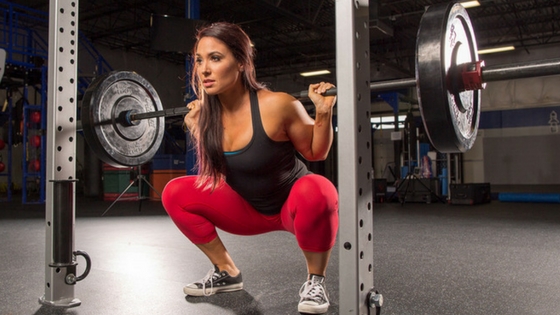CONNECT WITH ME ON SOCIAL MEDIA
There are many different barbell variations to choose from, so I’m gonna breakdown the differences and what you want to consider when choosing.
- Mobility limitation and injuries
- Focus muscles and weaknesses
- Posture and muscular imbalances
These key considerations make the difference between developing your lower body the way you want it and wrecking your joints. If you’re not sure how you should be squatting, keep reading.
Barbell Back Squat
This is the most commonly used barbell squat, probably because its the least technical one. Mounting the bar on your back allows you to squat more weight than other variations.
When done right, through a full range of motion, your quadriceps, hamstrings, and glutes are targeted pretty evenly. The bottom position is where you get the most muscular activation in the glutes and hamstrings.
Toes should be slightly turned out with your knees tracking in line with the toes. Forcing your knees out over your toes during each rep will protect your knees and really target your glute medius.
The glute medius sits right above your glute maximus and completes the roundness and fullness of your glutes.
Barbell Low Bar Back Squat
This is a slightly different variation of the conventional back squat where the bar rests a bit lower on your back. This changes the center of gravity, creating more of a bend at the hip and less of a bend at the knee.
This slight change in form targets the glutes and hamstrings more and is a great alternative to those with limited ankle mobility, or over developed quadriceps.
This squat variation places more of a demand on the torso, so if you have a weak core, back injury, or poor posture, this may not be the one for you.
Rest the bar right above your rear delts instead of directly at the top of your trapezius. Pull the bar in tight, squeezing your shoulder blades together.
Barbell Sumo Squat
The sumo squat is a great exercise for total glute development with a major focus on the glute medius. Being that the hamstrings aren’t as involved in this movement means more focus on the quadriceps.
This squat variation doesn’t require a great deal of mobility which is great for those who have limited hip and ankle mobility. Just make sure you’re doing accessory exercises for working on your limitations.
The stance here is going to be much wider, which is going to require a bit more flexibility in the inner thighs. You want to make sure that you maintain a vertical shin in the bottom position. As usual, your knees she track in line with your toes.
Barbell Front Squat
The front squat is a bit more technical because of its emphasis on torso stability and shoulder mobility. On the flip-side the key advantages are the safety. You don’t have to worry about getting stapled under the weight because you can just dump it in front of you.
The primary reasons for front squatting are quadricep development, core strength development, and posture improvement. This carries over to all of the other barbell squats making you much more efficient at squatting.
Staying as vertical as possible throughout each rep is a key focus here. Keep your chest up and elbows pointed straight ahead. Do not let your elbows touch your thighs.
In the video I show you a couple of techniques to use if you have limited shoulder mobility and can’t quite get the front racked position.
Barbell Zercher Squat
The zercher squat is a great alternative to the conventional barbell front squat. It doesn’t require the shoulder mobility, or as much torso stability. You might want to start here when first getting into front loading.
Start with the bar resting on your thighs and hook your arms under the bar. The bar should rest cradled right on the inside of the bend in your arm. Make sure the bar, and your arms do not touch your thighs.
This barbell variation puts much more concentration on the legs by taking a great deal of stress off of the torso. Still, you need to focus on maintaining a vertical position.
Having the bar rest in the crease of your arm may be a bit uncomfortable. Use a cushion on the bar for extra support.
Tribe By Noire

I’ve created this platform to help you become the most powerful version of yourself through fitness, plant based nutrition, and mindset coaching.
copyright © 2018 Tribe By Noire. All Rights Reserved
